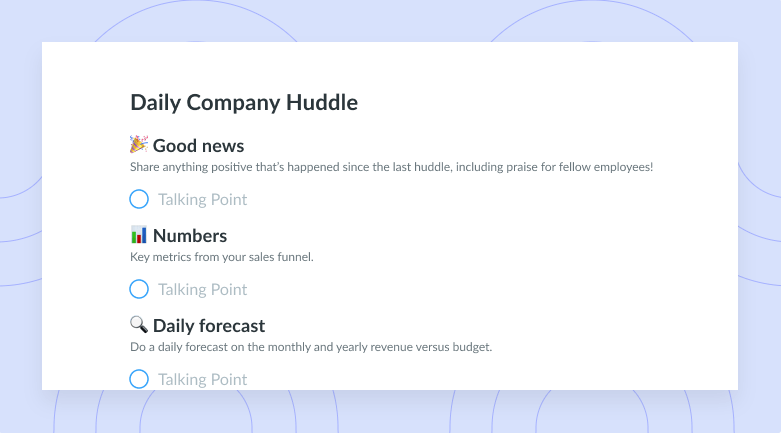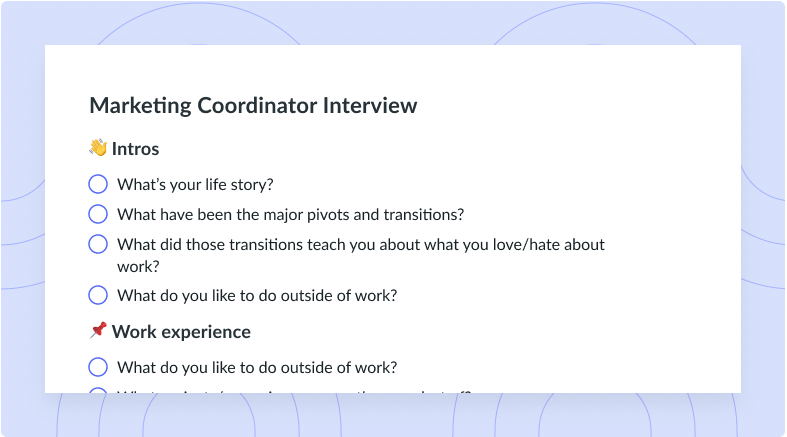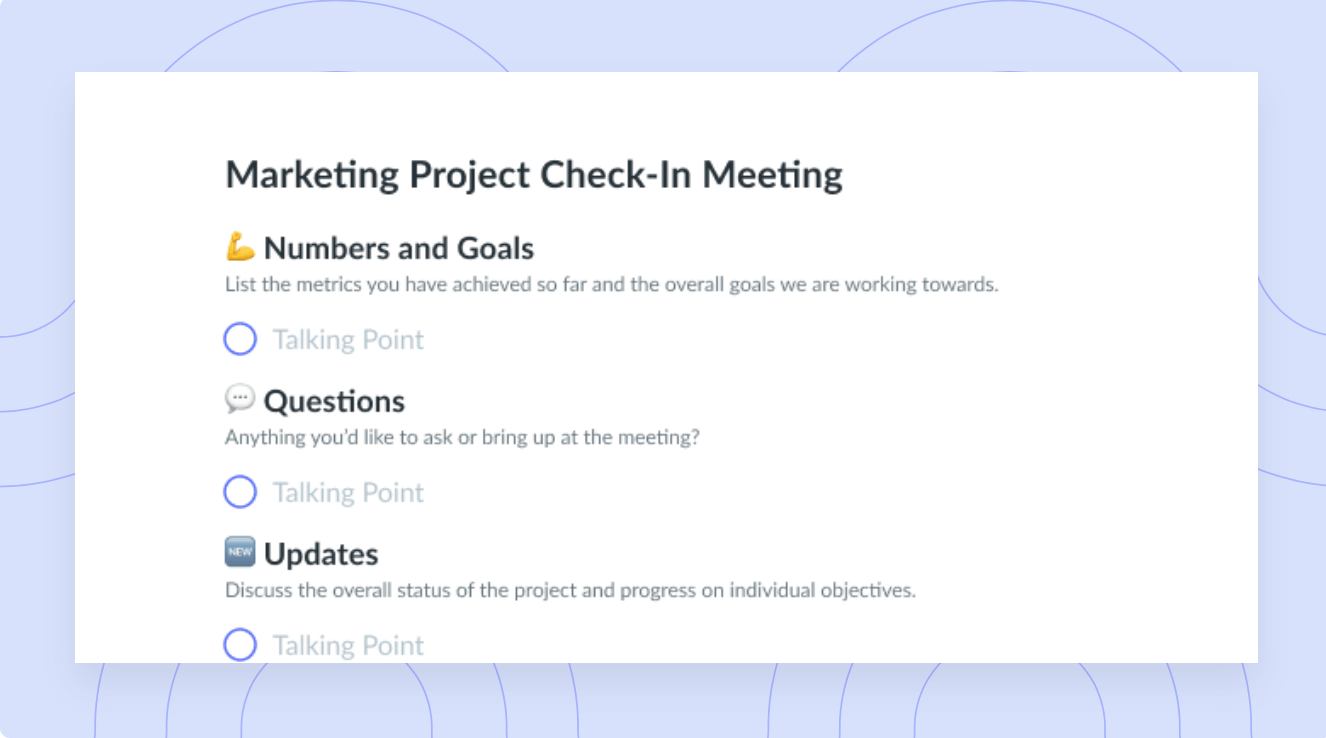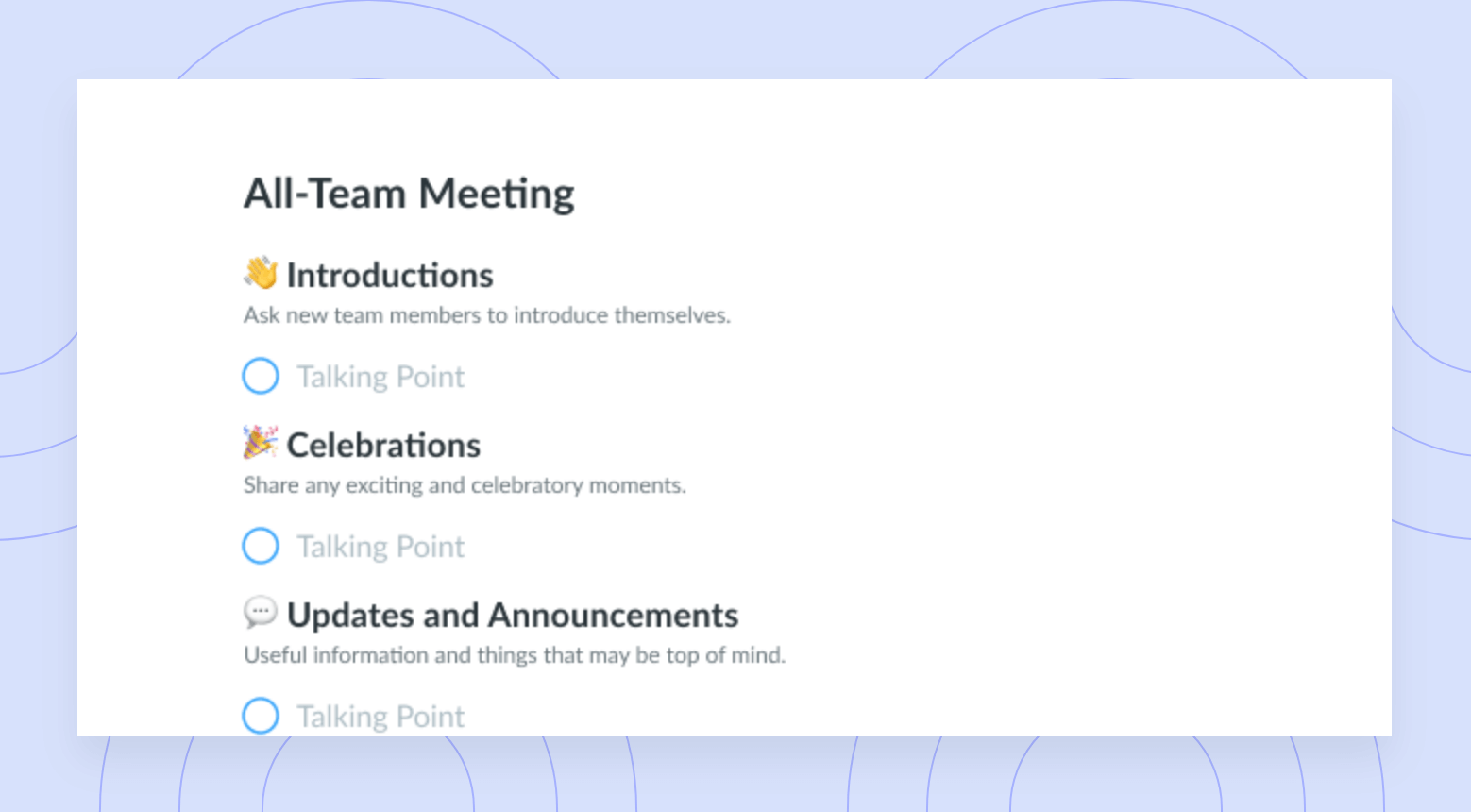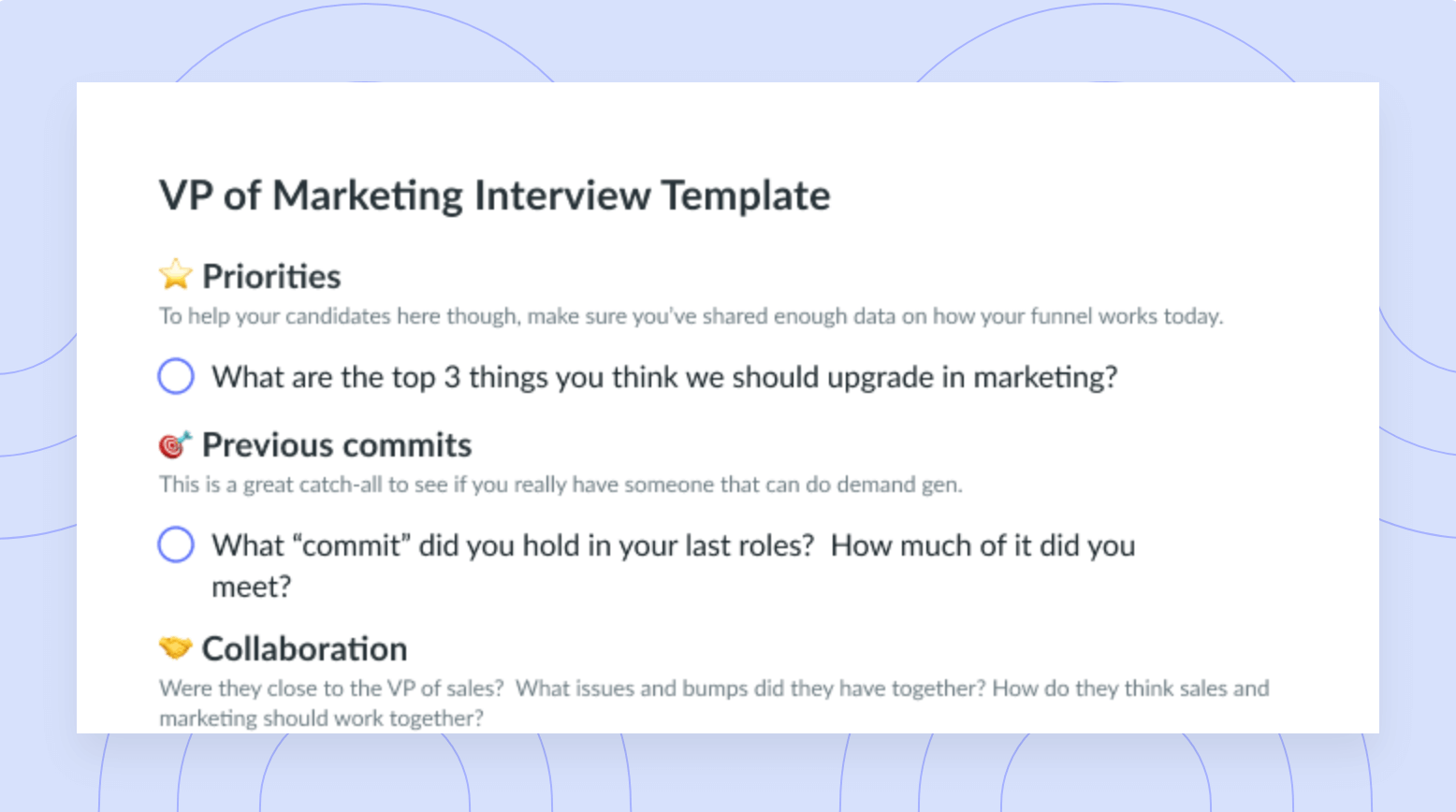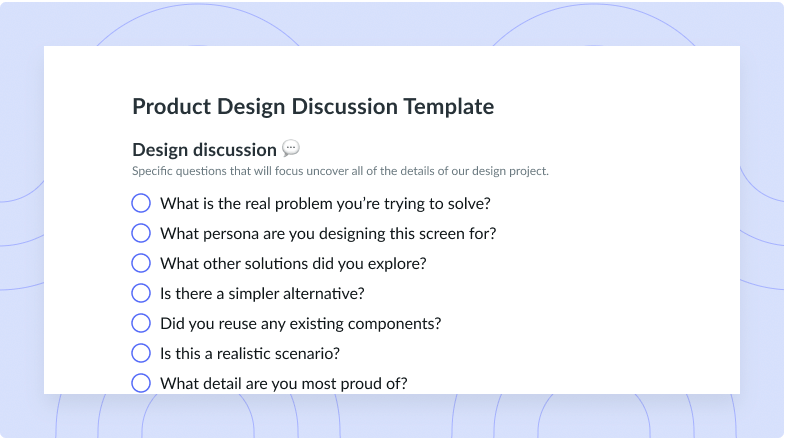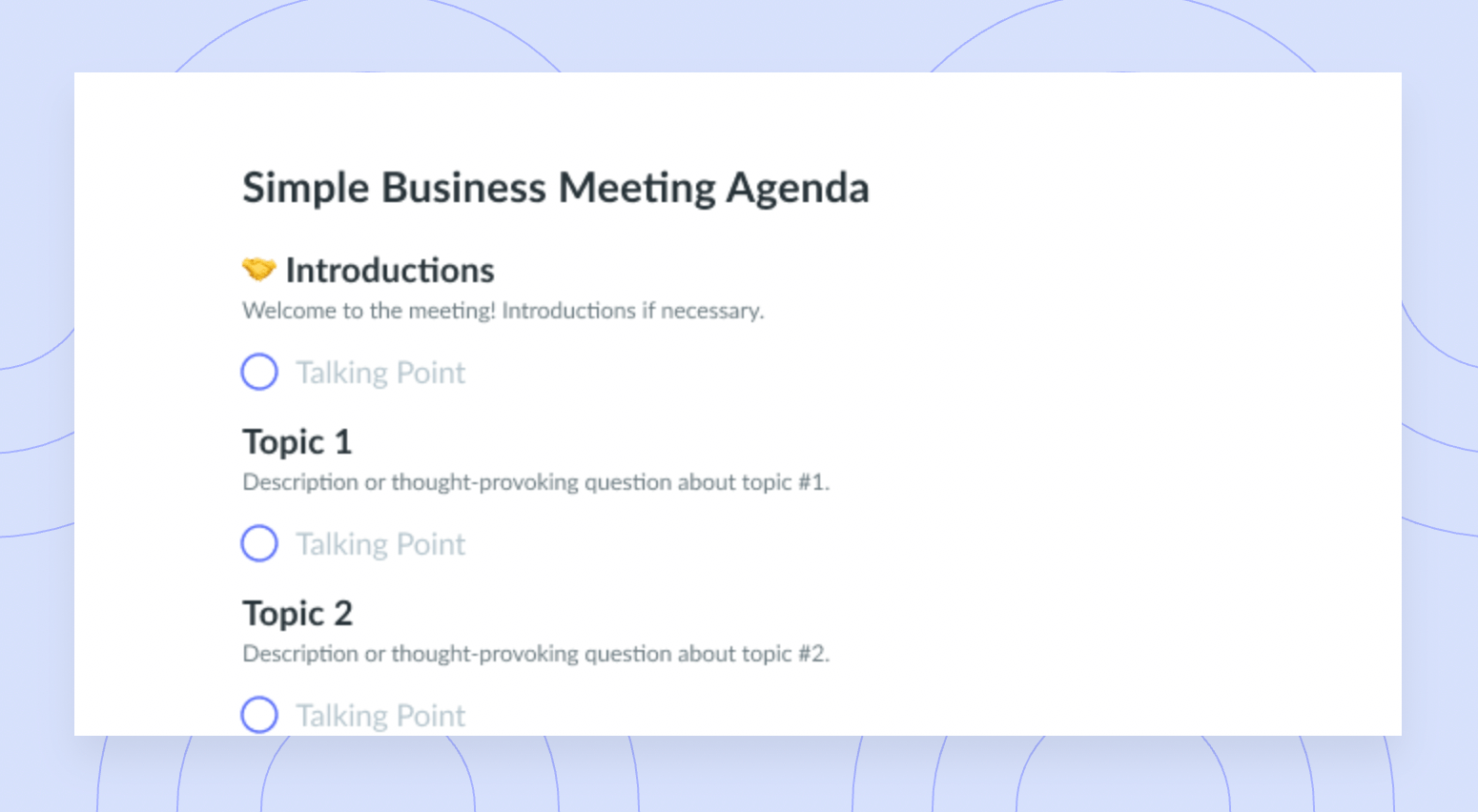How to Create a Perfect Meeting Agenda in 8 Easy Steps
Expert advice from Kevin Hoffman, Cameron Herold, Priya Parker, and Steven Rogelberg on the art of creating meeting agendas that actually work.
Think about all the meetings you attend in the span of one week: Project kick-offs, metrics reviews, team meetings, daily standups, one-on-one meetings… the list goes on and on.
The thing is, even though meetings get a bad reputation, they are how we get our work done:
- Customize an existing template
- Prepare your agenda in advance
- Think critically about who you’re inviting
- Make it collaborative
- Phrase your agenda items as questions
- Map out how much time each item will take
- Use feedback to improve the meeting agenda
- Identify the next step
“A meeting is something that enables us to achieve an outcome that we can’t otherwise achieve without it, measured in an agreed-upon fashion,” says Kevin F. Hoffman, author of the book Meeting Design. “A meeting is a mechanism for creating meaningful change in your work.”
If meetings are such an important part of our work lives, why aren’t we spending more time thinking about how to improve them? Why aren’t we designing them and constantly iterating on different meeting formats and styles? In Hoffman’s words:
“Well-designed things make our lives simpler or more pleasing. Something designed has been given appropriate and actionable consideration, with forethought and research guiding its creation and ongoing evolution.”
Well-designed meetings start with an agenda
According to Cameron Herold (a business coach and former COO of 1-800-GOT-JUNK), one thing that deserves appropriate consideration and ongoing evolution is your meeting agenda.
In the book Meetings Suck, Herold argues that taking the time to plan, prepare, and distribute a meeting agenda is one the most important aspects of designing an effective meeting:
“If you skip creating an agenda, then your meetings can quickly go off track, get hijacked by a random topic, or include people who shouldn’t be attending,” says Herold. “I’ve also found that without an agenda guiding the discussion, it’s also common for attendees to ramble, engage in simultaneous side-conversations, or devolve into catcalling – all outcomes detrimental to taking your company to the next level.”
But creating a collaborative meeting agenda with bullet points that guide the discussion is only the start. If you want your meeting agendas to drive results, collaboration, and accountability, you need to follow these 8 easy steps:
How to design the perfect meeting agenda
1 Customize an existing template
There’s no need to reinvent the wheel when you can try out the practices and tactics that are already working for other leaders and managers.
One of these tactics is to create a meeting agenda template for your recurring meetings.
For instance, if you run a weekly team meeting, it would make sense to reuse the same meeting agenda format every week. Or if you run bi-weekly one-on-one meetings, you could have a template that covers priorities, feedback, and career growth – so you wouldn’t have to go back and remember the things you’re supposed to talk about.
The good news? You don’t need to spend a lot of time thinking about what to write on your meeting agenda. There are a lot of existing meeting agenda templates out there that you can customize and reuse depending on your team’s needs.

Here are a few examples:
- For one-on-ones: One-on-one meeting template
- For team meetings: Team meeting agenda template
- For sales meetings: Sales meeting agenda template
- For marketing meetings: Marketing meeting agenda template
- For skip-level meetings: Skip-level meeting agenda template
- For remote teams: Remote team meeting template
- For daily standups: Daily standup meeting template
2 Prepare your agenda in advance
If your meeting is taking place on Tuesday afternoon, you shouldn’t wait for Tuesday morning to start updating your metrics and adding talking points under each heading in your template.
The second step to design the perfect meeting agenda is to start thinking about the topics you want to address at least 24 hours before the meeting begins:
“As a meeting leader, you are in the unique position of being a steward of others’ time and experience,” argues Steven G. Rogelberg in The Surprising Science of Meetings. “We would never go to a client meeting unprepared, nor would we conduct a workshop for others without planning; the same focus should be brought to a meeting. Prepare for an internal meeting like you would prepare a client event, even for just a few minutes.”
Basically, if your team meeting is taking place on Tuesday at 3 pm, you should start writing the main talking points on Monday morning.
Why? Because you’ll want to share that meeting agenda with those attending, at least 24 hours in advance (on Monday at 3 pm), so they can read any background materials and come prepared with thoughts and questions for the meeting.
And that leads us to step #3.
3 Think critically about who you’re inviting
In the book The Art of Gathering, Priya Parker argues that the desire to “keep doors open” is a threat to gathering with a purpose.
“Inviting people is easy. Excluding people can be hard,” says Parker. “‘The more the merrier,’ we are told from childhood. ‘The more souls, the more joy,’ the Dutch say. ‘The more fools there are, the more we laugh,’ the French declare. At the risk of dissenting from millenia of advice along these lines, let me say this: You will have begun to gather with purpose when you learn to exclude with purpose. When you learn to close doors,” says Parker.
Creating an agenda in advance forces you to think critically about who you’re inviting to the meeting. More often than not, meeting organizers show up to meetings only realize that they’ve invited too many people, and most of them are not even contributing to the discussion.
So, next time you’re planning a meeting, make sure to think twice about who you’re inviting and let your meeting agenda guide that decision.
According to Cameron Herold, sometimes you don’t need people to participate for the entire meeting, but for a shorter period of time (e.g. 10 minutes):
“When this occurs your invitation to them can be: ‘Come in. Give us four data points, and then you’re free to leave,’ or ‘Come in and listen to what we’re thinking, and tell us if it can be done.’ Maybe it’s an IT guy who needs to say yes or no to one question, but who doesn’t need to be present for the larger discussion,” says Herold. “I firmly believe it’s vital only to invite individuals for the portion of the agenda for which they’re needed.”
Finally, if you’re worried that some people will get offended because they weren’t invited to the meeting, you can follow one of Steven Rogelberg’s tips in The Surprising Science of Meetings:
“Another technique designed to make others not invited to the meeting feel included is to consult them before the meeting to get their input. This helps them feel involved, without being in the meeting itself,” says Rogelberg.
4 Make it collaborative
If you want to build a meeting agenda that is tailored to the needs of the team and will increase accountability, you should reach out to attendees for agenda items.
“If an agenda is not given to these individuals ahead of time, you will likely lose great ideas that will remain unspoken and will walk out of the room with them when the meeting is finished,” says Cameron Herold.
In order to bring all voices into the conversation and create a more inclusive environment, you can create a shared meeting agenda that is visible and editable by everyone on the team. This will give all attendees an equal chance to prepare and contribute with questions, comments, and concerns.
5 Phrase your agenda items as questions
Another great habit you should acquire is writing down talking points that provide context and give people a chance to think about their answers.
For instance, writing “What resources do we need to develop a new case study?” is better than writing “Case study” as one of your talking points.
“When it comes to your more introverted team members, more often than not, they won’t speak up unless you ask them a question directly or they’re passionate and engaged in the subject,” says Cameron Herold. “Giving them an agenda in advance allows them the time they need to think through answers, prepare a statement, or whatever else they need to do to raise their ideas.”
Putting just a few words on the agenda can cause some confusion amongst your colleagues. A question will help provide context and spark new ideas – even before the meeting starts.
6 Map out how much time each item will take
Once everyone’s done adding their talking points and you have a meeting agenda outline, it’s your role as a meeting organizer to estimate how much time will be spent on each topic ⏰.
In the book Meeting Design, Kevin M. Hoffman argues that you should design your meeting agendas based on the number of ideas, people, and minutes you have in mind:
“In an hour, you can explore about 15 ideas, but you’re probably better off doing a little less than that to allow time for tangents and some creative exploration,” says Hoffman.
Keep in mind how long the meeting is and how many topics you have to cover, and try to allocate more time to the most important (or controversial) topics in the agenda.
“If an agenda item is scheduled for three minutes and you know the next one is for fifteen minutes, then you can control your time, the flow of ideas, and communication more efficiently,” says Cameron Herold.
7 Use feedback to improve the meeting agenda
Just like UX designers get feedback on their products and iterate on their designs, managers and leaders must ask for feedback to make their meetings more effective.
“Sticking to a meeting format without further experimentation is like flying on auto-pilot,” argues Kevin M. Hoffman. “It only works for a limited amount of time. Symptoms of autopilot meetings include the same, strong personalities repeatedly driving the agenda and people tuning out, agreeing to whatever runs out the clock.”
If you lead or manage a team, one thing you can do to continually improve your team’s workflows is to incorporate opportunities for feedback into your team’s day-to-day experience. For instance, by asking your team for feedback about your meetings. The results might surprise you.
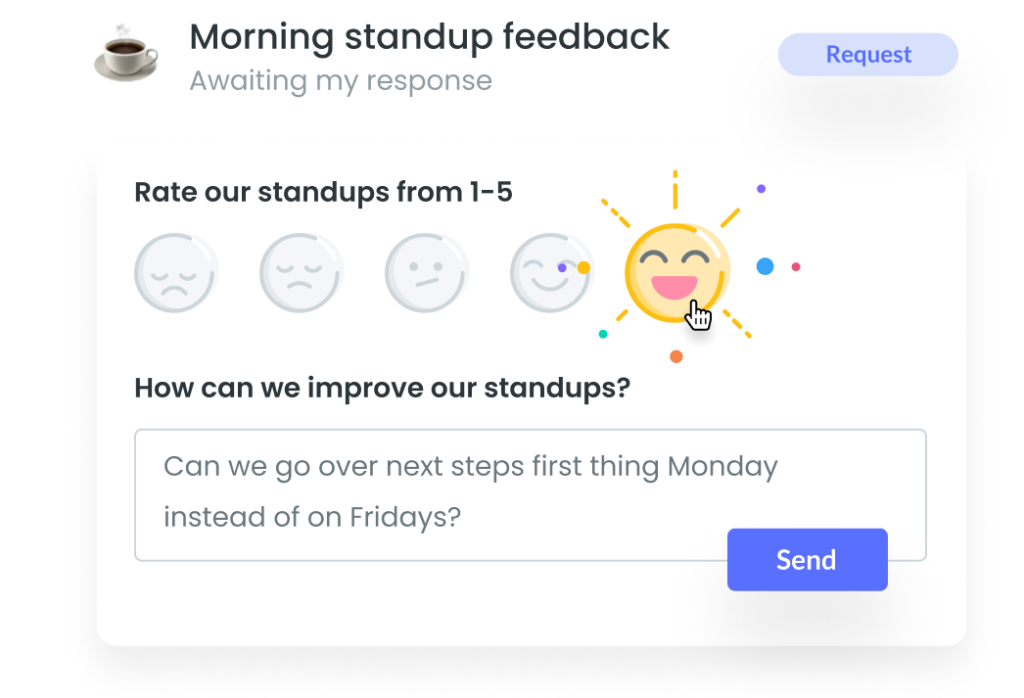
When interviewing a team lead at Shopify, we found that his weekly standup meeting agenda evolved from being a “non-stop list of project updates” into an agenda that included a 5-minute chat about people’s weekend, and a 5-minute “open-mic” section to ask any random questions at the end of the meeting.
This evolution took place after the meeting organizer asked the attendees for feedback on how to make the meeting better for everyone – and is a great example of something you can do as well!
8 Identify the next steps
Last but not least, don’t forget to include a section for action items at the bottom of your meeting agenda:
“It should always end in a similar way–closing with a few-minutes-long wrap-up to cover meeting takeaways, clarify alignments, and note some items that will be put on the agenda for the next time,” says Steven Rogelberg.
Crafting an amazing agenda won’t be very effective if nothing comes out of your meeting. That’s why every meeting should end with a discussion of your next steps, deadlines, and the people responsible for those actions. Only then will you have designed the perfect meeting agenda.

As Priya Parker argues in The Art of Gathering:
“A gathering is a moment of time that has the potential to alter many other moments of time. And for it to have the best chance of doing so, engaging in some meaning-making at the end is crucial.”
Recap (TLDR)
As Kevin M. Hoffman argues in the book Meeting Design:
“The meetings in an organization describe, define, and have the capability to change that organization’s culture. Being aware of the relationship between meetings and culture helps you use meetings as a tool to assess a variety of things, and make change.”
Create meeting agendas that drive your meetings (and your team culture) forward with these eight steps:
- Customize an existing template
- Prepare your agenda in advance
- Think critically about who you’re inviting
- Make it collaborative
- Phrase your agenda items as questions
- Map out how much time each item will take
- Use feedback to improve the meeting agenda
- Identify the next steps
Books Quoted
- Meeting Design: For Managers, Makers, and Everyone by Kevin M. Hoffman.
- Meetings Suck: Turning One of the Most Loathed Elements of Business Into One of the Most Valuable by Cameron Herold.
- The Art of Gathering: How We Meet and Why It Matters by Priya Parker.
- The Surprising Science of Meetings: How You Can Lead Your Team to Peak Performance by Steven G. Rogelberg.
![How to Run an Effective Weekly Team Meeting [Free Agenda Templates]](https://fellow.app/wp-content/uploads/2019/10/Weekly-Team-Meeting-Agenda-Template.jpg)





![8 Types of Company Culture [with Examples]](https://fellow.app/wp-content/uploads/2020/10/Types-Company-Culture.jpg)


